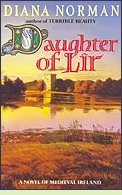|
Daughter of Lirby Diana NormanReviewed by Margaret Donsbach In 1154, six-year-old Finola is left at a Norman convent. Spirited and intelligent, she wins the mother superior's heart with her knowledge of horseflesh and grows up determined to rise in the convent heirarchy. Her big chance comes in an unexpected, unwelcome form. She is an over-confident eighteen-year-old when King Henry II's political maneuverings get her shipped to Ireland to become Abbess of Kildare, a lifetime position embellished with customs more pagan than Christian, inherited in a direct line from Saint Brigid herself. Carried "on a gilded throne" to a church "crazy with colour," she feels "swelled with the indecency of power." Ruling over both nuns and monks, Finola delights in her new prominence until she realizes how vulnerable her illiteracy makes her. When she interferes with King Dermot of Leinster's war plans, she learns the ultimate meaning of male power: he attacks the abbey and has her raped and removed from office. Devastated, emotionally damaged, she has a chance to rebuild her life, but must discard an entire belief system and accept a frightening level of risk. If she succeeds, she will have the tools to wield power again, more deftly and wisely, but certainly not in safety. Daughter of Lir is less grim and more humorous than its subject matter suggests. Norman pokes gentle fun at her characters' medieval certainties and prejudices, part of the reason Finola holds a reader's sympathy despite attitudes typical of her time. Indeed, many characters are surprisingly sympathetic - except for the heartless Dermot, who eventually suffers an appropriately horrible fate. (1988; 379 pages) More about Daughter of Lir at Amazon.com
R.A. MacAvoy, The Book of Kells (1985), a mild-mannered artist and his assertive lover slip back in time to tenth-century Ireland. Cecelia Holland, The Kings in Winter Robin Morgan, The Burning Time (2006), about a fourteenth century pagan priestess in Ireland who fights back against the Inquisition; based on the true story of Alyce Kyteler. Review at Bookslut
Dermot, King of Leinster, and the Foreigners by Nicholas Furlong (1973). More info The Norman Invasion of Ireland by Richard Roche (1970). More info Ireland in the Middle Ages by Sean Duffy (1996). More info
Dermot and Strongbow, and the Invasion of Ireland at Ireland-Information.com Back to Novels of the Medieval Celts
|
